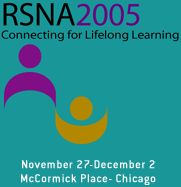
Abstract Archives of the RSNA, 2005
Hala Mohamed El-Shenshawy MD,PhD, Abstract Co-Author: Nothing to Disclose
Ahmed Yousef Kandeel MD, PhD, Presenter: Nothing to Disclose
Saleh Mohamed Elessawey, Abstract Co-Author: Nothing to Disclose
To compare the efficacy, side effects and re-treatment and pathological fracture rates in single fraction versus multiple fractions radiotherapy in treatment of painful bone metastases. Also to evaluate the degree of remineralization resulting from palliative radiotherapy using computed tomography bone density measurments in osteolytic bone metastases
One hundred and fifty patients with painful bone metastases were included into a prospective randomized trial comparing 8 Gy single fraction with multifraction regimens (20 Gy/5 or 30 Gy/10 fractions. Only thirty patients with osteolytic bone metastases had CT bone density before and 3 months after radiotherapy.
The overall survival at 12 months was 38% (p=0.284). The overall pain response rates for single fraction and multifraction radiotherapy were 78% and 79%, respectively (p=0.888), indicating no difference between the two radiotherapy schedules. There was also no difference in complete pain response rates for single fraction 34% and multifrcation 32% radiotherapy (p=0.806). Patients treated by single radiotherapy had a higher re-treatment rate 22% compared with 7% of patients in the mutifraction group (p=0.008). The pathological fracture rate was also higher in single fraction radiotherapy group 6% compared with 2% for those treated by multifraction radiotherapy (p=0.043). The median % density change following single 8 Gy, 20 Gy/5 fractions and 30 Gy/10 fractions were; 105, 128 1nd 181 respectively (p=0.049). The median % density change of complete responders and partial responders were 243 and 128 (p=0.0001). There is also significant difference between the pathological fracture and the bone density(p=0.001).
Single fraction radiotherapy was as effective as multifraction radiotherapy in relieving metastatic bone pain. However, the re-treatment and pathological fracture rates were higher after single fraction radiotherapy. The CT bone density measurment showed remineralization of osteolytic bone metastases after palliative radiotherapy. Moreover, there is statistical correlation between dose fractionation schedules, response and pathological fracture with bone density range before and 3 months after treatment.
El-Shenshawy, H,
Kandeel, A,
Elessawey, S,
The Effect of Single Fraction Compared to Multiple Fractions Radiotherapy on Painful Bone Metastases with Evaluation of Computed Tomography Bone Density in Osteolytic Bone Metastases. Radiological Society of North America 2005 Scientific Assembly and Annual Meeting, November 27 - December 2, 2005 ,Chicago IL.
http://archive.rsna.org/2005/4416716.html

